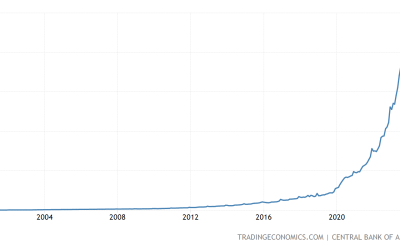In the late 1980s, a fascinating debate broke out over free banking. Economist Murray Rothbard (1926-1995) wrote in a journal of his editorship a blasting critique of a seminal work on banking history by Lawrence White: Free Banking in Britain (1984). It was surprising because Rothbard himself had praised White’s work for years, devoting several pages of his own 1983 book The Mystery of Banking to celebrating White’s scholarship:
After the founding of the Bank of England, English banking, during the eighteenth and first half of the nineteenth centuries, was riven by inflation, periodic crises and panics, and numerous—and in one case, lengthy—suspensions of specie payment. In contrast, neighboring Scottish banking, not subject to Bank of England control and, indeed, living in a regime of free banking, enjoyed a far more peaceful and crisis-free existence. Yet the Scottish experience has been curiously neglected by economists and historians…. Scottish banking, in contrast to English, was notably freer of bank failures, and performed much better and more stably during bank crises and economic contractions.
Then came the turn. Rothbard’s 1988 article, “The Myth of Free Banking in Scotland,” included as an appendix in a later edition of the same book, reads:
White’s thesis on Scottish banking has been hastily and uncritically accepted by many diverse scholars, including the present writer. This has been particularly unfortunate because, as I shall demonstrate, both parts of Professor White’s syllogism are wrong. That is, the Scottish banks were (1) not free—indeed, they too pyramided upon the Bank of England—and (2) not surprisingly, they worked no better than the English banks…. I conclude that the Scottish banks, in the eighteenth and first half of the nineteenth centuries, were neither free nor superior, and that the thesis to the contrary, recently revived by Professor White, is but a snare and a delusion.
What happened?
Rothbard changed his mind; his 1988 article explained why. He advanced the argument that Scotland wasn’t the free banking paradise that White allegedly made it out to be, and thereby concluded that this historical case offered no real lessons for the proper direction of reform. While the critique had no impact on the continued high academic standing of White’s book, the broadside stuck in some circles. Among some Austrians, any mention of “free banking” and “Scotland” in the same sentence now runs up against the assertion that Rothbard rebutted the “myth” of free banking in Scotland, so pointing to Scotland while making any banking-related argument is null and void. Case closed.
This won’t do.
For those of us who actually care to look at the history, what we find are major mistakes in Rothbard’s revision of his earlier views. Let’s have a look at his major mistakes and take it as given history has never seen a purely free banking system, but rather varying degrees of regulated banks. The job of the economic historian is to look at the real history with the hope of discerning lessons, not merely to impose some idealized system as the judge and jury of all existing experience and declare thereby that there is nothing to see here. The jargon among scholars today is that the task is to evaluate “relatively unregulated banking systems.”
Rothbard’s case boiled down to three historical points where he aimed to show that Scottish banks were dependent on the Bank of England, and so by association tainted by an emergent central bank. Quod erat demonstrandum.
All three arguments are factually wrong — or contain enough mistakes for us to discard his case.
1. The Proportion of Banks Failing
One piece of White’s evidence involves the failure rates of English and Scottish banks. English banks during the relevant period (1700-1845) collapsed much more frequently than their Scottish counterparts. This, White argues, supports his thesis that free banking Scotland worked better than proto–central banking England. Rothbard objected — correctly — that there’s something fishy about an entire industry whose firms do not go bust. Over longer time periods, we ought to see any thriving industry weeding out the least competitive companies. Thus, as even Huerta de Soto outlined last year, there must have been some government support preventing banks from failing.
This is a reasonable insight, but the case is not so clear. Scottish banks did fail — just much less frequently than banks in other countries. In order for Rothbard’s objection to be correct, he must provide us with some evidence for his position that they did not fail— which he did not in 1988 and, to the best of my knowledge, nor has any other historian. Hitchens’s razor states that that which has been asserted without evidence can be rejected without evidence.
Ironically, Rothbard himself cited this very evidence of lower rates of failure in his The Mystery of Banking and praised Scottish banking for performing better than their English counterparts. This was thanks in no small part to much freer regulations, decentralized reserve holdings, and widespread circulation of bank notes.
The objection is nevertheless made moot since White’s (and others’) position does not rely exclusively on banks’ failure rates, despite Rothbard’s believing so. Number of bank offices and assets per capita were all higher for Scottish banks, and competition (measured as the interest rate spread between deposits and lending) was fiercer than elsewhere.
2. Bank Restriction (1797-1821) Was Breach of Contract
When the British Parliament separated the pound from specie (gold) during the Napoleonic wars, this law applied to Scotland as well. Rothbard argued that Scottish banks refused to fulfill their contractual obligations to savers when they refused to pay out gold. Thus, he concluded, Scottish banks simply “pyramided credit on top of the Bank of England.” It is curious, Rothbard noted, that not a single case of contractual breach was brought before the courts. Consequently, the government must have legalized such fraud.
This is completely false. First, physical gold was extremely rare in Scottish commercial transactions. Bills of exchange and bank notes were used by the Scottish population, possibly more so than in any other banking system. Consequently, the commercial banks’ specie reserves were very low (2 to 5 percent of assets) — not because the government mandated it, but because customers rarely requested specie.
Second, as George Selgin explained in a three-part review on Alt-M, the restriction on specie payment referred to the Bank of England and the Bank of Ireland alone. In other words, it was perfectly legal for creditors to demand gold from their Scottish banks — and charge them with lawsuits if they refused.
The benefits hardly exceeded the costs of doing so: it was both costly and time-consuming; the assets were frozen during the process, as opposed to bank notes, which could effortlessly be used in transactions; most creditors were also customers of the banks, and using legal means to force one’s own bank into liquidation would seem like a pretty bad idea.
Rothbard noted a few cases where depositors were apparently treated poorly by their banks, and concluded that banks in general refused to fulfill their obligations. There are no reasons to believe that is even remotely accurate.
3. The Bank of England Was a Lender of Last Resort to the Scottish Banks
Again, Rothbard’s strange historical twist makes an appearance. He pointed to a financial crisis in 1793 and noted that Scottish banks received lender-of-last-resort financing by the Bank of England. In February 1793, France declared war on Britain and money markets came to a standstill. The Royal Bank of Scotland, one of the few limitedly liable banks (owners of Scottish free banks were generally unlimitedly liable for all the bank’s debts), had run into liquidity problems when its commercially dependent Glasgow merchants returned bills unpaid. Allegedly, the Royal Bank received government funds during the crisis — its collapse was thus prevented in an early instance of lender-of-last-resort lending.
Interestingly, the £200,000 that the Royal Bank borrowed from London seems to have been in the form of newly issued Exchequer bills — that is, short-term trade credit from the Treasury. Rothbard’s point of a public bailout may be vindicated, but as far as I can tell, the support doesn’t seem to have come from the Bank of England. And it hardly undermines the free banking case that a single bank under liquidity pressure (created by a quintessential government intervention, by the way) received public funds. We might just as well retort that a resilient and efficient Scottish banking system could have absorbed and dealt with the losses involved.
Moreover, Rothbard seems to have believed that because Scottish banks held accounts with the Bank of England, they must have been dependent on the Bank — and Scotland’s system was therefore no more than a satellite to the English proto–central banking system. Many Scottish banks had accounts with the Bank of England in London — or had correspondence relations with London discount houses that did.
The explanation is simple: trade and clearing. London was Great Britain’s (and consequently the world’s) financial center, and holding deposits or credits on London-based banks constituted efficient payment service for Scottish clients. In the past, like today, clearing between banks is simplified by holding one another’s debt.
Scottish banks occasionally borrowed money from the Bank or England or other London-based banks — or Amsterdam or Hamburg or anywhere else; they bought, imported, and borrowed funds from wherever they could receive attractive rates when liquidity was desired. Nobody ever argued that Dutch bankers were lenders-of-last-resort to Scottish banks just because there were credit relations across the North Sea. You may advocate such a strange position, but in that case the “tainted by central banking” accusation no longer applies.
We can point to another Scottish crisis, the Ayr Bank (Douglas, Heron & Co) collapse in 1772 to illustrate the point even further. Upon the brink of collapse, the Ayr Bank’s directors desperately tried to get a bailout from the Bank of Scotland. That bank’s directors refused. So the directors turned to the Bank of England, which offered such expensive and humiliating terms that the directors turned down the loan. That’s not exactly what we picture when we think of a lender of last resort.
Moreover, when banking historians go through the minutes of Scottish banks, it is clear (says, for instance, Charles Munn) that the Bank of England was not a crucial — or even frequently occurring — portion of Scottish banks’ business.
The Bottom Line
Recall White’s core thesis here: Scottish banking was less regulated and hence more stable and well-functioning than England’s banking system in the same 145-year period. This matters because it points to an important historical example of the application of the principle of the free market to the industry of banking. This is why White’s book was so important in forging a new research path and shifting part of the mainline academic opinion on the matter of decentralization in money and banking.
Nothing in Rothbard’s later view manages to cast doubt on his earlier view and White’s thesis, much less refute them. It seems rather, in retrospect, to have been little more than a paradigmatic case of the imposition of perfectionist normative judgments on a history that sadly provides us no flawless cases of freedom anywhere. This is precisely why the demands of evidence, applied in the context of good theory, are so crucial. White provided both theory and evidence; his critic Rothbard, whose first impressions of banking in Scotland were correct, declined in his rejoinder to grapple with either.
Made available by the American Institute for Economic Research. Visit their website at https://www.aier.org.




